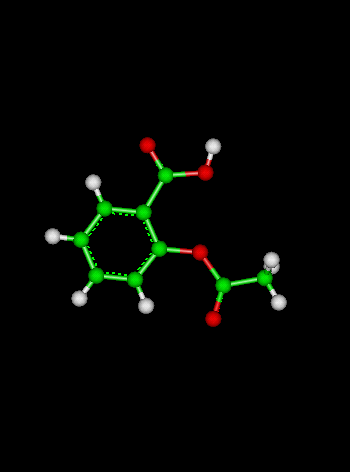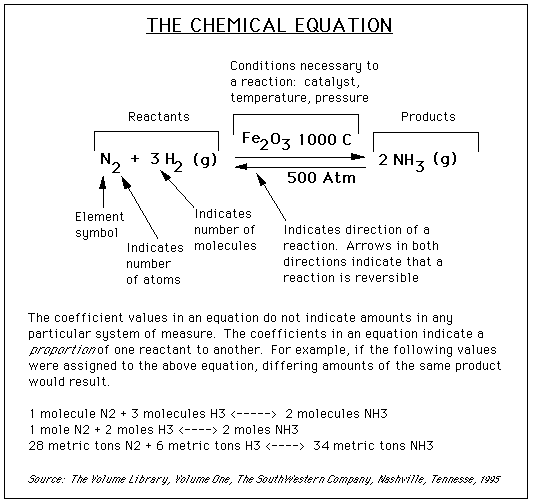
Course Chapters
Section Tests
Online Calculators Linear Least Squares Regression Newton's Method Equation Solver
Related Information Links
|
| ||||||||||||||||||||||||||||||||||||||||||||||||||||||||||||||||||||||||||||||||||||||||||||||||||||||||
| 6.0 g C2H2 x | (24.0 + 2.0)g C2H2 |
= 0.25 mol C2H2 |
Then, because there are five (5) molecules of oxygen to every two (2) molecules of C2H2, we need to multiply the result by 5/2 to get the total molecules of oxygen. Then we convert to grams to find the amount of oxygen that needs to be added:
| 0.25 mol C2H2 x | 2 mol C2H2 |
x | 1 mol O2 |
= 20 g O2 |
Percent Composition
It is possible to calculate the mole ratios (also called mole fractions) between terms in a chemical equation when given the percent by mass of products or reactants.In percent composition problems, there are many possible solutions. It is always possible to double the answer. For example, CH and C2H2 have the same proportions, but they are different compounds. It is standard to give compounds in their simplest form, where the ratio between the elements is as reduced as it can be-- called the empirical formula. When calculating the empirical formula from percent composition, one can convert the percentages to grams. For example, it is usually the easiest to assume you have 100 g so 54.3% would become 54.3 g. Then we can convert the masses to moles; this gives us mole ratios. It is necessary to reduce to whole numbers. A good technique is to divide all the terms by the smallest number of moles. Then the ratio of the moles can be transferred to write the empirical formula.
Example: If a compound is 47.3% C (carbon), 10.6% H (hydrogen) and 42.0% S (sulfur), what is its empirical formula?
To do this problem we need to transfer all of our percents to masses. We assume that we have 100 g of this substance. Then we convert to moles:
| Carbon: | 1 |
x | 12.01 grams |
= 3.94 moles |
| Hyrdrogen: | 1 |
x | 1.008 grams |
= 10.52 moles |
| Sulfur: | 1 |
x | 32.07 grams |
= 1.310 moles |
Now we try to get an even ratio between the elements so we divide by the number of moles of sulfur, because it is the smallest number:
| Carbon: | 1.310 |
= 3 |
| Hydrogen: | 1.310 |
= 8 |
| Sulfur: | 1.310 |
= 1 |
So we have: C3H8 S
Example: Figure out the percentage by mass of hydrogen sulfate, H2SO4.
In this problem we need to first calculate the total mass of the compound by looking at the periodic table. This gives us:
2(1.008) + 32.07 + 4(16.00) g/mol = 98.09 g/mol
Now, we need to take the weight fraction of each element over the total mass (which we just found) and multiply by 100 to get a percentage.
| hydrogen: | 98.09 |
= | 98.09 |
= 0.0206 ∗ 100 = 2.06% |
| sulfur: | 98.09 |
= 0.327 ∗ 100 = 32.7% | ||
| oxygen: | 98.09 |
= | 98.09 |
= 0.652 ∗ 100 = 65.2% |
Now, we can check that the percentages add up to 100%
So the answer is that H2SO4 is made up of 2.06% H, 32.7% S, and 65.2% O by mass.
Empirical Formula and Molecular Formula
While the empirical formula is the simplest form of a compound, the molecular formula is the form of the term as it would appear in a chemical equation. The empirical formula and the molecular formula can be the same, or the molecular formula can be any positive integer multiple of the empirical formula. Examples of empirical formulas: AgBr, Na2S, C6H10O5. Examples of molecular formulas: P2, C2O4, C6H14S2, H2, C3H9.One can calculate the empirical formula from the masses or percentage composition of any compound. We have already discussed percent composition in the section above. If we only have mass, all we are doing is essentially eliminating the step of converting from percentage to mass.
Example: Calculate the empirical formula for a compound that has 43.7 g P (phosphorus) and 56.3 grams of oxygen. First we convert to moles:
1 |
x | 30.97 grams |
= 1.41 moles | ||
1 |
x | 16.00 grams |
= 3.52 moles | ||
Next we divide the moles to try to get an even ratio.
| Phosphorus: | 1.41 |
= 1.00 |
| Oxygen: | 1.41 |
= 2.50 |
When we divide, we did not get whole numbers so we must multiply by two (2). The answer = P2O5
Calculating the molecular formula once we have the empirical formula is easy. If we know the empirical formula of a compound, all we need to do is divide the molecular mass of the compound by the mass of the empirical formula. It is also possible to do this with one of the elements in the formula; simply divide the mass of that element in one mole of compound by the mass of that element in the empirical formula. The result should always be a natural number.
Example: if we know that the empirical formula of a compound is HCN and we are told that a 2.016 grams of hydrogen are necessary to make the compound, what is the molecular formula? In the empirical formula hydrogen weighs 1.008 grams. Dividing 2.016 by
1.008 we see that the amount of hydrogen needed is twice as much. Therefore the empirical formula needs to be increased by a factor of two (2). The answer is:
H2C2N2.
Density
Density refers to the mass per unit volume of a substance. It is a very common term in chemistry.
Concentrations of Solutions
The concentration of a solution is the "strength" of a solution. A solution typically refers to the dissolving of some solid substance in a liquid, such as dissolving salt in water. It is also often necessary to figure out how much water to add to a solution to change it to a specific concentration.The concentration of a solution is typically given in molarity. Molarity is defined as the number of moles of solute (what is actually dissolved in the solution) divided by the volume in liters of solution (the total volume of what is dissolved and what it has been dissolved in).
| Molarity = | liters of solution |
Molarity is probably the most commonly used term because measuring a volume of liquid is a fairly easy thing to do.
Example: If 5.00 g of NaOH are dissolved in 5000 mL of water, what is the molarity of the solution?
One of our first steps is to convert the amount of NaOH given in grams into moles:
1 |
x | (22.9 + 16.00 + 1.008)g |
= 0.125 moles |
Now we simply use the definition of molarity: moles/liters to get the answer
| Molarity = | 5.00 L of soln |
= 0.025 mol/L |
So the molarity (M) of the solution is 0.025 mol/L.
Molality is another common measurement of concentration. Molality is defined as moles of solute divided by kilograms of solvent (the substance in which it is dissolved, like water).
| Molality = | kg of solvent |
Molality is sometimes used in place of molarity at extreme temperatures because the volume can contract or expand.
Example: If the molality of a solution of C2H5OH dissolved in water is 1.5 and the mass of the water is 11.7 kg, figure out how much C2H5OH must have been added in grams to the solution.
Our first step is to substitute what we know into the equation. Then we try to solve for what we don't know: moles of solute. Once we know the moles of solute we can look at the periodic table and figure out the conversion from moles to grams.
|
Now we simply use the definition of molarity: moles/liters to get the answer
|
|||||
|
|||||
|
|||||
|
It is possible to convert between molarity and molality. The only information needed is density.
Example: If the molarity of a solution is 0.30 M, calculate the molality
of the solution knowing that the density is 3.25 g/mL.
To do this problem we can assume one (1) liter of solution to make the numbers easier. We need to get from the molarity units of mol/L to the molality units of mol/kg. We work the problem as follows, remembering that there are 1000 mL in a Liter and 1000 grams in a kg. This conversion will only be accurate at small molarities and molalities.
1 L |
x | 3.25 g |
x | 1000 mL |
x | 1 kg |
= 0.09 mols / kg |
It is also possible to calculate colligative properties, such as boiling point depression, using molality. The equation for temperature depression or expansion is
Where:
ΔT is temperature depression (for freezing point) or temperature expansion (for boiling point) (°C)
Kf is the freezing point constant (kg °C/mol)
m is molality in mol/kg
Example: If the freezing point of the salt water put on roads is -5.2° C, what is the molality of the solution? (The Kf for water is 1.86 °C/m.)
This is a simple problem where we just plug in numbers into the equation. One piece of information we do have to know is that water usually freezes at 0° C.
ΔT = Kf * m
ΔT/Kf = m
m = 5.2/1.86
m = 2.8 mols/kg
Practice Problems
2. If 2.0 moles of sucrose weighing 684 g is put in 1000 g of water and is then dissolved, what would be the molality of the solution?
3. If you have a 0.25 M solution of benzene with a density of 15 g/L, calculate the molality of the solution.
4. If the density of mercury is 13.534 g/cm3 and you have 62.5 cm3 of mercury, how many grams, moles, and atoms of mercury do you have? (Mercury has a mass of 200.6 g/mol.)
[Basic Index]
[Chemical Nomenclature]
[Atomic Structure]
[Periodic Table]
[Lewis Structure]
[Chemical Reactions]
[Stoichiometry]
[Acid-Base Chemistry]
 Shodor
Shodorin cooperation with the Department of Chemistry,
The University of North Carolina at Chapel Hill
Copyright © 1996-2008 Shodor
Last Update: Sunday, 06-Oct-2002 13:08:39 EDT
Please direct questions and comments about this page to
[email protected]
